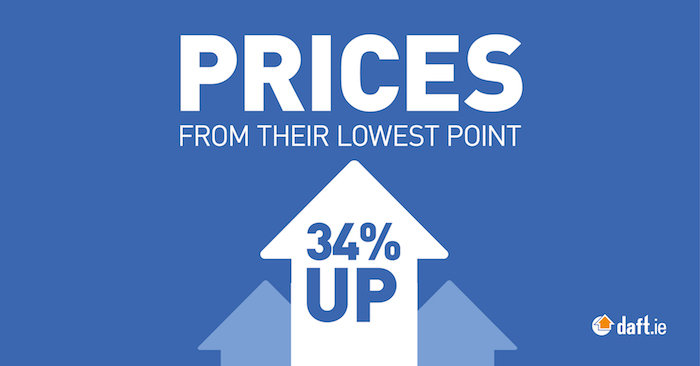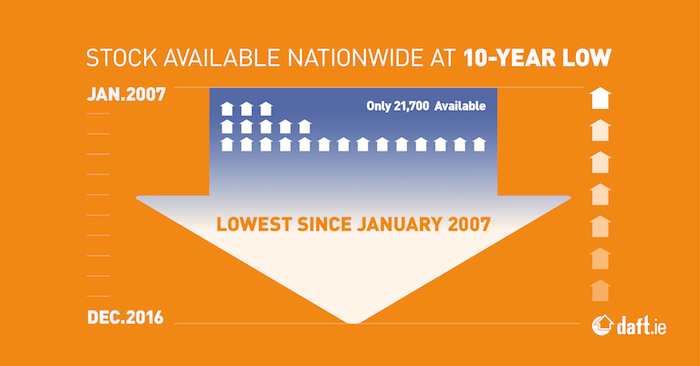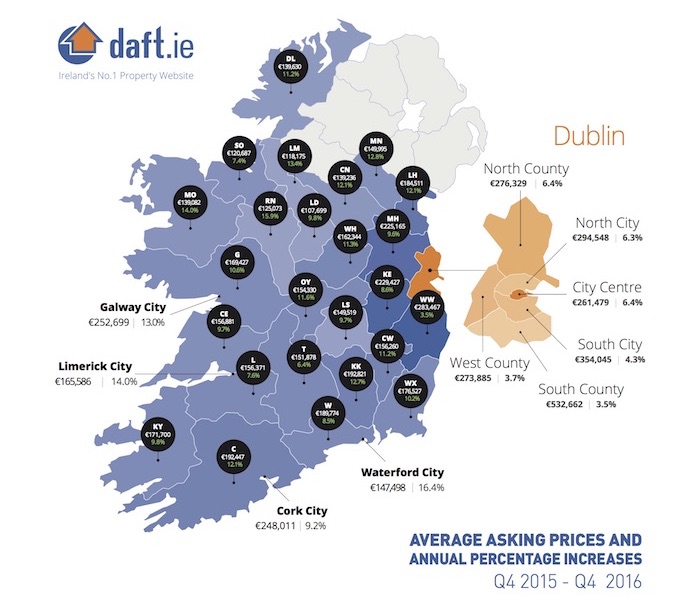Irish House Price Report Q4 2016 | Daft.ie
Daft Reports
- Ronan Lyons (House Price, Q1 2024)
- Ronan Lyons (Rental Price, Q4 2023)
- Ronan Lyons (House Price, Q4 2023)
- Ronan Lyons (Rental Price, Q3 2023)
- Ronan Lyons (House Price, Q3 2023)
- Ronan Lyons (Rental Price, Q2 2023)
- Ronan Lyons (House Price, Q2 2023)
- Ronan Lyons (Rental Price, Q1 2023)
- Ronan Lyons (House Price, Q1 2023)
- Ronan Lyons (Rental Price, Q4 2022)
- Ronan Lyons (House Price, Q4 2022)
- Ronan Lyons (Rental Price, Q3 2022)
- Ronan Lyons (House Price, Q3 2022)
- Ronan Lyons (Rental Price, Q2 2022)
- Ronan Lyons (House Price, Q2 2022)
- Ronan Lyons (Rental Price, Q1 2022)
- Ronan Lyons (House Price, Q1 2022)
- Ronan Lyons (Rental, Q4 2021)
- Ronan Lyons (House Price, Q4 2021)
- Ronan Lyons (Rental, Q3 2021)
- Ronan Lyons (House Price, Q3 2021)
- Ronan Lyons (Rental, Q2 2021)
- Ronan Lyons (House Price, Q2 2021)
- Ronan Lyons (Rental, Q1 2021)
- Ronan Lyons (House Price, Q1 2021)
- Ronan Lyons (Rental, Q4 2020)
- Ronan Lyons (House Price, Q4 2020)
- Ronan Lyons (Wealth, H2 2020)
- Ronan Lyons (Rental, Q3 2020)
- Ronan Lyons (House Price, Q3 2020)
- Ronan Lyons (Housing, July 2020)
- Ronan Lyons (Housing, June 2020)
- Ronan Lyons (Housing, May 2020)
- Ronan Lyons (Rental, Q1 2020)
- Ronan Lyons (House Price, Q1 2020)
- Ronan Lyons (Rental, Q4 2019)
- Ronan Lyons (House Price, Q4 2019)
- Ronan Lyons (Wealth, H2 2019)
- Ronan Lyons (Rental, Q3 2019)
- Ronan Lyons (House Price, Q3 2019)
- Pierre Yimbog (Rental, Q2 2019)
- Ronan Lyons (House Price, Q2 2019)
- Ronan Lyons (Wealth, H1 2019)
- Ronan Lyons (Rental, Q1 2019)
- Ronan Lyons (House Price, Q1 2019)
- Ronan Lyons (Rental, Q4 2018)
- Ronan Lyons (House Price, Q4 2018)
- Ronan Lyons (Wealth, H2 2018)
- Ronan Lyons (Rental, Q3 2018)
- Ronan Lyons (House Price, Q3 2018)
- Shane De Rís (Rental, Q2 2018)
- Ronan Lyons (House Price, Q2 2018)
- Ronan Lyons (Wealth, 2018)
- Ronan Lyons (Rental, Q1 2018)
- Ronan Lyons (House Price, Q1 2018)
- Ronan Lyons (Rental, Q4 2017)
- Ronan Lyons (House Price, Q4 2017)
- Ronan Lyons (Rental, Q3 2017)
- Ronan Lyons (House Price, Q3 2017)
- Katie Ascough (Rental, Q2 2017)
- Ronan Lyons (Wealth, 2017)
- Ronan Lyons (House Price, Q2 2017)
- Ronan Lyons (Rental, Q1 2017)
- Ronan Lyons (House Price, Q1 2017)
- Ronan Lyons (Rental, Q4 2016)
- Ronan Lyons (House Price, Q4 2016)
- Ronan Lyons (Rental, Q3 2016)
- Ronan Lyons (House Price, Q3 2016)
- Ronan Lyons (School Report, 2016)
- Conor Viscardi (Rental, Q2 2016)
- Ronan Lyons (Rail Report, 2016)
- Ronan Lyons (House Price, Q2 2016)
- Ronan Lyons (Rental, Q1 2016)
- Ronan Lyons (House Price, Q1 2016)
- Ronan Lyons (Rental, Q4 2015)
- Ronan Lyons (House Price, Q4 2015)
- Ronan Lyons (Rental, Q3 2015)
- Ronan Lyons (House Price, Q3 2015)
- Marcus O'Halloran (Rental, Q2 2015)
- Ronan Lyons (House Price, Q2 2015)
- Ronan Lyons (Rental, Q1 2015)
- Ronan Lyons (House Price, Q1 2015)
- Ronan Lyons (Rental, Q4 2014)
- Ronan Lyons (House Price, Q4 2014)
- Ronan Lyons (Rental, Q3 2014)
- Ronan Lyons (House Price, Q3 2014)
- Domhnall McGlacken-Byrne (Rental, Q2 2014)
- Ronan Lyons (House Price, Q2 2014)
- Ronan Lyons (Rental, Q1 2014)
- Ronan Lyons (House Price, Q1 2014)
- Ronan Lyons (Rental, Q4 2013)
- Ronan Lyons (House Price, Q4 2013)
- Ronan Lyons (Rental, Q3 2013)
- Ronan Lyons (House Price, Q3 2013)
- Ronan Lyons (Rental, Q2 2013)
- Ronan Lyons (House Price, Q2 2013)
- Ronan Lyons (Rental, Q1 2013)
- Ronan Lyons (House Price, Q1 2013)
- Ronan Lyons (Rental, Q4 2012)
- Ronan Lyons (House Price, Q4 2012)
- Lorcan Sirr (Rental, Q3 2012)
- Padraic Kenna (House Price, Q3 2012)
- John Logue (Rental, Q2 2012)
- Ronan Lyons (House Price, Q2 2012)
- Barry O'Leary (Rental, Q1 2012)
- Seamus Coffey (House Price, Q1 2012)
- Joan Burton (Rental, Q4 2011)
- Ronan Lyons (House Price, Q4 2011)
- Philip O'Sullivan (Rental, Q3 2011)
- Sheila O'Flanagan (House Price, Q3 2011)
- Rachel Breslin (Rental, Q2 2011)
- Constantin Gurdgiev (House Price, Q2 2011)
- Cormac Lucey (Rental, Q1 2011)
- Eoin Fahy (House Price, Q1 2011)
- Lorcan Roche Kelly (Rental, Q4 2010)
- Ronan Lyons (House Price, Q4 2010)
- John Fitzgerald (Rental, Q3 2010)
- Patrick Koucheravy (House Price, Q3 2010)
- Gary Redmond (Rental, Q2 2010)
- Jim Power (House Price, Q2 2010)
- Jill Kerby (Rental, Q1 2010)
- Brian Lucey (House Price, Q1 2010)
- Michael Taft (Rental, Q4 2009)
- Alan McQuaid (House Price, Q4 2009)
- Dr. Charles J. Larkin (Rental, Q3 2009)
- Emer O'Siochru (House Price, Q3 2009)
- Ronan Lyons (Rental, Q2 2009)
- Oliver Gilvarry (House Price, Q2 2009)
- Brian Devine (Rental, Q1 2009)
- Dr. Liam Delaney (House Price, Q1 2009)
- Gerard O'Neill (Rental, Q4 2008)
- Ronan Lyons (House Price, Q4 2008)
- Dr. Stephen Kinsella (Rental, Q3 2008)
- Moore McDowell (House Price, Q3 2008)
- Shane Kelly (Rental, Q2 2008)
- Fergal O'Brien (House Price, Q2 2008)
- Eoin O'Sullivan (Rental, Q1 2008)
- Dermot O'Leary (House Price, Q1 2008)
- Dan O'Brien (Rental, Q4 2007)
- Frances Ruane (House Price, Q4 2007)
- John McCartney (Rental, Q3 2007)
- Ronnie O'Toole (House Price, Q3 2007)
- Ronan Lyons (Rental, Q2 2007)
- Constantin Gurdgiev (House Price, Q2 2007)
- Fintan McNamara (Rental, Q1 2007)
- Rossa White (House Price, Q1 2007)
- Geoff Tucker (Rental, Q4 2006)
- Damien Kiberd (House Price, Q4 2006)
- Pat McArdle (House Price, Q3 2006)
- Marc Coleman (House Price, Q2 2006)
- David Duffy (House Price, Q1 2006)
- Austin Hughes (House Price, Q4 2005)
- David McWilliams (House Price, Q2 2005)

3rd Jan 2017
Supply, supply, supply: the new housing mantra
Nationally, the average list price rose by 8% in 2016, very similar to the 8.5% seen in 2015. Compared with static prices in 2013 - although this masked huge regional differences - and an increase of almost 15% in 2014, perhaps this, then, is the new normal.
Normal does not mean healthy, however. We know that in a healthy housing system, any extra demand for more housing is offset by more supply - in other words, the real price of housing should be stable, once general inflation is taken account of. In Ireland, general inflation has effectively been zero not just over the last 12 months but indeed over the last decade.

So Ireland is currently trapped in a situation where housing prices are increasing far faster than prices in the rest of the economy. This is not sustainable but the latest indications are that this high rate of inflation is embedded in the market, due to strong demand and weak supply.
We know from the initial Census results that the country added 170,000 extra people between 2011 and 2016. Given the likely composition of new households - between 2 and 2.5 people per household on average - this means that the country added almost 75,000 new households in those five years.
We know from the same source, the Census, that there were just 17,000 new homes added to the stock of dwellings in the last five years, once holiday homes are excluded. In other words, for every ten new families formed, just two new dwellings were built, for the entire period from 2011 to 2016. (Completions numbers were much higher than this, but this includes properties built during the bubble and only connected to the electricity grid more recently. It is also a measure of "gross" construction and doesn't account for buildings going obsolete.)

Bad as that may seem, the picture is worse again. Firstly, the period 2011-2016 was largely one of net emigration, with 125,000 people leaving between 2011 and 2015. There is a clear move toward net immigration, though, emigration falling from 90,000 to 75,000 since 2013 while immigration has risen from slightly more than 50,000 in 2012 to 80,000 this year.
Migration is driven by those in their 20s and 30s, in other words the very groups forming households and starting families. Based on the 2011 Census, we know that every additional 10,000 migrants require on average 4,000 dwellings, so even if net migration remains relatively low - at say 20,000 a year over the next few years - that will add 8,000 to the number of new homes required annually.
This is in addition to the core demand resulting from "natural increase", in other words a surplus of families being formed over families dying. A fast way of checking the size of this natural increase is to compare the size of the cohorts of women aged 30 and 80. There are roughly 35,000 women aged 30 in Ireland currently, which gives a good baseline of household formation - ultimately, the vast majority of these women are likely to be part of one household each. There are just 10,000 women aged 80. Thus, there is a natural increase in number of households each year of at least 20,000 and closer to 25,000.
On top of this, demographics are changing - not least, people are living longer. Coupled with other factors, including a greater fraction of people who do not have any children, separation and divorce, Ireland's average household size has fallen from more than 4 people in 1971 to roughly 2.7 people today. However, it is still the highest in Europe, where the average is just 2.3.
This may sound like a small difference but it is hugely important for how many new homes are needed per year. For example, if Ireland's population did not increase but the average household size fell from 2.7 to 2.3, an additional 300,000 dwellings would be needed. Realistically, that convergence will take time, but it is likely that declining household size will add at least 10,000, if not 15,000, to the number of new homes needed each year.

The last factor when figuring out how many new homes are needed each year is one that is most often forgotten: obsolescence. The Department of Housing and CSO estimate that roughly 0.8% of the housing stock goes obsolete each year: in other words, the typical dwelling lasts about 125 years. This means that, every year, about 16,000 dwellings fall out of use.
That figure seems somewhat high and, while 125 years may be an accurate guide for rural cottages, urban properties typically remain in use due to renovations. But even a depreciation rate of 0.5% a year would mean 10,000 dwellings are needed annually just to stand still.
Adding all these up, there are roughly 10,000 dwellings needed each year to offset obsolescence, a further 10,000-15,000 needed to accommodate Ireland's smaller households, between 20,000 and 25,000 on top of that to house the natural increase - and to top it all off, likely a further 8,000 or so due to net migration.
In total, Ireland needs at least 40,000 new dwellings a year and probably closer to 50,000. These will be concentrated in and near the urban centres and will be disproportionately homes for one- and two-person households, such as apartments, downsizer homes and student accommodation. As the latest figures show, without this kind of supply, we will all have to spend more and more of our income just to have a home.

